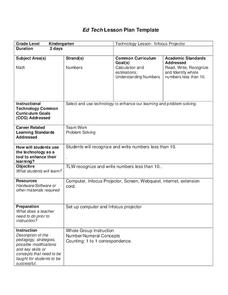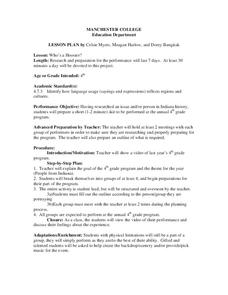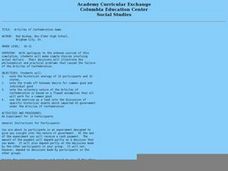Curated OER
Numbers One To Ten
Students read, write, and identify whole numbers one through ten. They explore a variety of websites and complete a WebQuest, count fish and match the numbers to the correct number of fish, and complete a fish counting worksheet.
Curated OER
THE OCCUPATION OF KOREA BY JAPANESE IMPERIALIST FORCES
Students read and respond to a history of Korea. In this occupation lesson, students work in groups to research the effects of Japanese occupation and create an illustrated timeline. Students listen to a lecture and write an acrostic....
Curated OER
Who's a Hoosier?
What is a Hoosier? 4th graders will identify sayings/expressions to reflect a region or culture. They will research Indiana history to work in groups to prepare for the annual 4th grade program where they will present the information...
Curated OER
Descriptive Writing Using the Book Rumpelstiltskin
Use the fairy tale Rumpelstiltskin to teach your third grade class about descriptive writing. Following a teacher read-aloud of the story, the class brainstorms a list of adjectives describing the main character. Students use this list...
Curated OER
Compound Words - My Baseball Book
First graders examine compound words and what they look like. For this compound word lesson, 1st graders read the book, My Baseball Book, and compile a list of compound words from their reading.
Curated OER
Introduction to Exponents
Problem solve using exponents. Pupils read One Grain of Rice: A Mathematical Folktale and write powers to represent amounts from the story.They compare actual solutions to their predictions and play a game to practice using...
Curated OER
How To Write a Social Studies Outline
One of the keys to success in school is organization. This resource leads learners through the process of creating an outline for a chapter from a social studies text. In addition, they review facts they have learned in their class...
Curated OER
Sequence, Predict, Infer: Pink and Say
Practice sequencing with your 2nd graders via Patricia Polacco's Civil War book Pink and Say. Begin with a blindfold and a bag of mystery items. Connect their use of clues to identify what they can't see with the skill of making...
Curated OER
Comparing Cinderella and The Rough-Face Girl
Pupils examine similarities and differences between cultures. They'll see that literature, reading, and story telling is something all cultures have in common. They should construct Venn diagrams to help them compare and contrast the...
Curated OER
School Life Today and in the Past at Freyberger School
Students compare and contrast school life today with that of Pennsylvania in the 1900's. In this school life lesson students create a description of a typical one-room schoolhouse. They think critically about attending school in a...
Curated OER
Literature Circles
Fourth graders work in groups in order to motivate one another to develop reading comprehension and literacy skills. The skills are built through the sharing of fine literature. They maintain a reading log to keep accountable for the...
Curated OER
Ten Prompts for Student Writing
Build writing skills and creative thinking. Writers are given a variety of thought-provoking writing prompts to choose from. After they choose what they will write about they share their pieces with the class.
Curated OER
Number Line Snacks: Compare Numbers to 10
Kindergarteners put Cheerios or cheddar fish on two number lines (up to 10 each) and identify which number the snack pieces indicate. They compare numbers after eating a few of each snack, and get an introduction to addition and...
Curated OER
Pre-Columbian Cultures in the Americas
Native American studies is fun, educational, and highly motivating. Fifth graders will gain a deeper understanding of the six major pre-Columbian culture areas on the North American continent. They will choose one group and conduct...
Curated OER
Rainforest (Elementary, Social Studies)
Explore the rainforest with your class. Learners study the meaning of the word endangered, choose an animal to study, gather data, and discuss why the animal is in danger of extinction. This is a motivating way to have your class discuss...
Curated OER
Articles of Confederation Game
Why did the Articles of Confederation fail? Your historians will find out firsthand through this simulation activity, during which they will use money (consider using extra credit) to demonstrate the inherent flaws. It's simple: each...
Curated OER
1,000 Cranes with a Pal
Students write a letter to a pen pal about the book they read 1,000 Cranes in Hiroshima. In this writing lesson plan, students write about the conflicts and events that occurred in the book.
Curated OER
Symbols of America
Third graders choose an American symbol and write a poem about it. In this American symbols lesson plan, 3rd graders view and discuss the purpose of some American symbols and then write at least 5 lines in a poem about it.
Curated OER
Social Studies: Bridging the Gap Between Cultures
Have you special education class examine multiculturalism. By exploring the cultures of Israel and Greece, they discover the holidays, cuisine, arts, andgeography of the countries. During this twelve-week unit, students develop a...
National Geographic
Mapping the Shape of Everest
With Mount Everest as the motivator, your earth science class learns about topographic maps. Begin by showing a film clip from The Wildest Dream: Conquest of Everest, featuring fearsome virtual imagery of a path up world's tallest...
Curated OER
Finding Captain Hook's Treasure
Students use their map-reading skills to find Captain Hook's treasure. They see how the directions on a map correspond with "real-life" directions, and that symbols on a map represent real things.
Curated OER
Tapestry in the Middle Ages
Students study the use of tapestry in the daily lives of those living during the Middle Ages. They design and create a weaving of their own detailing artists' use of visual language and symbols throughout history. They write a story that...
Curated OER
Art On Trial (A Mock-Court Activity)
Students engage in a mock trial to decide if a work of prospective public art is "art" and accepted for a city park. They broaden their definitions of what "art" is. Students distinguish between opinion and informed judgment of art works.
Curated OER
Projecting the Image -- What Can One Person Do?
Students research individuals who have received the Nobel Peace Prize. They identify the importance of their actions for the common good. They make note of their background, motivations and values.























